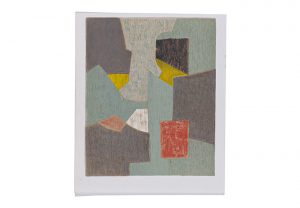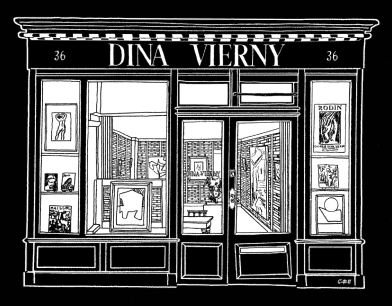All Exhibitions here

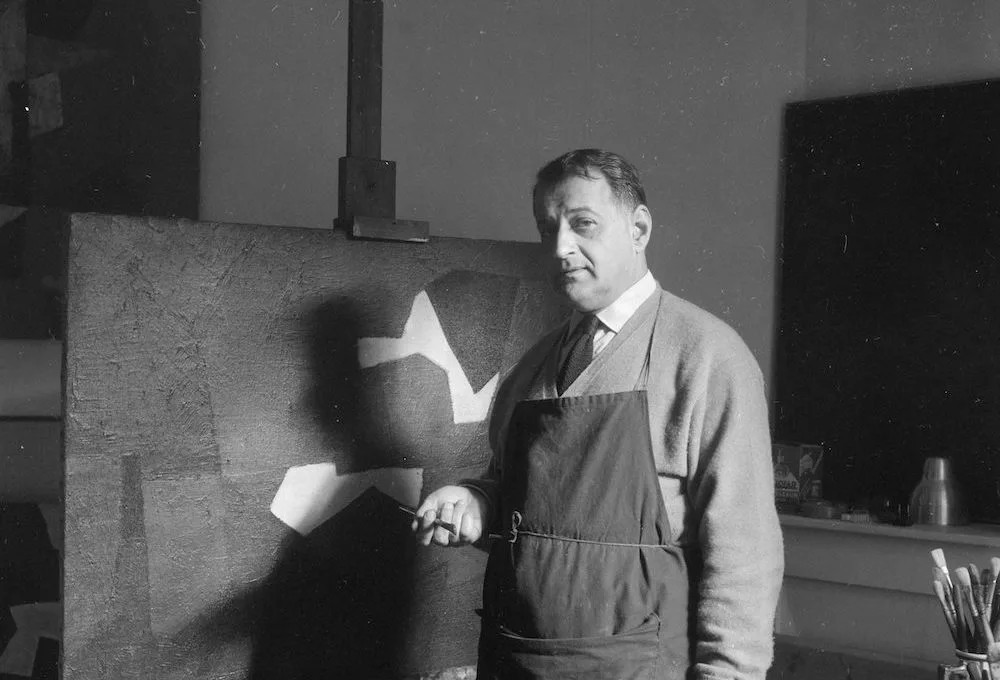
Serge Poliakoff is a painter the major figures of the École de Paris at the beginning of the year 1900 in Moscow. This artisit is the thirteenth of fourteen children. His father is a supplier of horses for the Russian army and owns a racehorse stable. In 1914, he begins to take drawing lessons and spends his childhood between religious icons he sees in churches with his mother and the vibrant cultural life and literary salons of the Russian aristocracy. In 1918, his exodus across Europe begins, accompanying his aunt,…
Serge Poliakoff is a painter the major figures of the École de Paris at the beginning of the year 1900 in Moscow. This artisit is the thirteenth of fourteen children. His father is a supplier of horses for the Russian army and owns a racehorse stable.
In 1914, he begins to take drawing lessons and spends his childhood between religious icons he sees in churches with his mother and the vibrant cultural life and literary salons of the Russian aristocracy.
In 1918, his exodus across Europe begins, accompanying his aunt, a famous singer, playing the guitar. He finally arrives in Paris in 1923 and begins his long training that will last for twenty years.
In 1937, he becomes close to the Delaunay painters whose theoretical discussions greatly assist his development. Two years later, he exhibits his first abstract painting and compositions in Paris. Noted by the painter Kandinsky, who says, “I bet on Poliakoff for the future.” He then participates in several salons and organizes his first exhibition of abstract paintings in 1945. The artist subsequently receives the Kandinsky Prize in 1947.
Meanwhile, to make ends meet, Serge Poliakoff creates successful fabric designs. However, he abandons this activity for fear that it might adversely affect his painting and compositions. Instead, he prefers to play the guitar in Russian cabarets at night.
He is then exhibited several times at the Denise René Gallery. From 1951 onwards, he exhibits at the Dina Vierny Gallery after their chance meeting in a Russian cabaret where Dina Vierny was replacing a sick singer.
The artist can finally enjoy success in the 1950s and 60s with numerous exhibitions and awards, as well as his participation in the 1962 Venice Biennale. He passes away in 1969, just before his major retrospective at the Museum of Modern Art in Paris.
Deeply influenced by Russian icons, he tries in his painting to convey the same emotion. This iconic aspect is reflected in his admiration for Malevich’s “White Square on White Background,” which had a significant impact on his work.
This painter seeks to express the presence of existence in his work, searching for a pre-figurative primitivism. Like the American artists of his generation (Rothko, Gottlieb, Newman). This is expressed in the balance of forms in his compositions, with the soul of the work relying on the vibration and colorful intensity emanating from it. Serge Poliakoff did not seek novelty in his painting but eternity, turning his paintings into true divine images, icons of modern art.
Serge Poliakoff : Silent Paintings, Timothee Taylor, Londres (14 janvier – 21 février)
Poliakoff, le rêve des formes, Musée d’Art Moderne de la Ville de Paris, Paris (18 octobre 2013 au 23 février 2014)
Serge Poliakoff – 60 ans déjà, Galerie Dina Vierny, Paris (11 mai – 28 juillet)
Serge Poliakoff, Musée des Beaux-Arts, Dunkerque (2 mars – 2 juin)
Serge Poliakoff, Association Campredon Art et Culture, L’Isle-sur-la-Sorgue, (7 avril – 10 juin)
Serge Poliakoff, Fondation Dina Vierny – Musée Maillol, Paris (20 novembre – 14 avril 1996)
Serge Poliakoff, Fondation Pierre Gianadda, Martigny, (31 janvier – 29 mars)
Serge Poliakoff, Association Campredon Art et Culture, L’Isle-sur-la-Sorgue (4 juillet – 12 octobre)
Serge Poliakoff, Galerie Dina Vierny, Paris (octobre)
Serge Poliakoff, Musée Ingres, Montauban (26 avril – 26 mai)
Serge Poliakoff, Musée des Beaux-Arts, La Chaux-de-Fonds
Rétrospective Poliakoff, Palais des Beaux-Arts, Charleroi (30 septembre – 2 novembre)
Serge Poliakoff, Musée Fabre, Montpellier (23 juillet – 15 octobre)
Serge Poliakoff, Musée des Beaux-Arts, Copenhague (3 mars – 9 avril)
Serge Poliakoff, Musée de Tel-Aviv, Tel-Aviv (27 décembre – 1er janvier 1972)
Serge Poliakoff, Musée National d’Art Moderne, Paris (22 septembre – 16 novembre)
Serge Poliakoff, Galerie Dina Vierny, Paris (29 septembre – octobre)
Serge Poliakoff, Galerie Dina Vierny, Paris (1er – 30 juin)
Serge Poliakoff, Museum am Ostwall, Dortmund (2 novembre – 1er décembre)
Salle Poliakoff, Pavillon Français, 31e Biennale, Venise (16 juin – 7 octobre)
Serge Poliakoff, Kunsthalle, Berne (9 avril – 15 mai)
Loan Exhibition of Paintings by Serge Poliakoff, The Phillips Collection, Washington D.C ( 15 février – 10 mars)
Jacobsen – Poliakoff, Stateus Museum for Kunst, Copenhague (30 mai – 15 juin)
Serge Poliakoff, Knoedler Galleries, New York, (10 – 29 octobre)
Serge Poliakoff, Galerie Martinet, Amsterdam (4 – 23 mars)
Serge Poliakoff, Galerie Bing, Paris (28 octobre – 28 novembre)
Serge Poliakoff, Circle & Square Gallery, New York (3 – 21 mars)
Poliakoff – Gilioli, Palais des Beaux-Arts, Bruxelles (25 avril – 6 mai)
Serge Poliakoff, Galerie Dina Vierny, Paris (21 novembre – 12 décembre)
Serge Poliakoff, Galerie Denise René, Paris (11 février – 2 mars)
Serge Poliakoff, Galerie Tokanten, Copenhague (16 – 28 octobre)
Serge Poliakoff, Galerie Zak, Paris (septembre)
Accrochage d’été, Galerie Dina Vierny, Paris (1er – 30 juillet)
Au cœur de l’abstraction – Collection de la Fondation Gandur pour l’Art, Fondation Marguerite et Aimé Maeght, Saint-Paul de Vence (2 juillet – 20 novembre)
Gilioli – Poliakoff, Galerie Dina Vierny, Paris (8 avril – 4 juillet)
Exposition anniversaire 70 ans, Galerie Dina Vierny, Paris (25 janvier – 24 mars)
Paris : Capital de las Artes 1900-1968, Museo Guggenheim, Bilbao (27 mai – 3 septembre)
L’Art Russe en Exil à Paris, 1920-1970, Musée d’Art Moderne et d’Art Contemporain, Nice (30 juin – 30 septembre)
Manifeste – une Histoire parallèle 1960-1990, Centre Georges Pompidou, Paris (23 septembre – 13 décembre)
Polyptiques, Musée du Louvre, Paris (27 mars – 23 juillet)
Salon International des Musées et Expositions, Grand Palais, Paris (15 – 20 janvier)
Art Français du XXe Siècle, Salle Poliakoff, National Museum of Modern and Contemporary Art, Séoul (26 août – 31 octobre)
Salon d’Automne, Hommage à Serge Poliakoff, Grand Palais, Paris (5 – 29 novembre)
L’abstraction lyrique en Europe, Musée d’Art Contemporain, Montréal
Paris – New York, Musée national d’Art moderne – Centre Georges Pompidou, Paris (1er juin – 19 septembre)
Collections, Musée d’Art moderne de la Ville de Paris, Paris
Art du XXe Siècle – collections genevoises, Musée Rath, Genève (28 juin – 23 septembre)
L’École de Paris dans les collections luxembourgeoises, Musée d’Art et d’Histoire, Luxembourg (mai)
8th International Art Exhibition of Japan (prix international de la Biennale de Tokyo), Tokyo
33e Biennale, Venise
Arp, Dubuffet, Fautrier, Giacometti, Herbin, Mathieu, Mortensen, Osborne, Poliakoff, Vasarely, Vieira da Silva, Kunsthaus, Zürich
Acquisitions 1953-1961, The Solomon R. Guggenheim Museum, New York (19 avril – 21 juin)
L’École de Paris dans les Collections Belges, Musée National d’Art Moderne, Paris (9 juillet)
Exposition Universelle 50 ans d’Art Moderne, Palais International des Beaux-Arts, Bruxelles (17 avril – 19 octobre)
Serge Poliakoff, Fahr El Nissa Zeid, James Pichette, Galerie Dina Vierny, Paris (29 octobre – 15 novembre)
Bloc, Dewasne, Deyrolle, Herbin, Mortensen, Poliakoff, Vasarely, A.P.I.A.W., Liège (16 – 28 octobre)
Collection Philippe Dotremont, Stedelijk Museum, Amsterdam
Tendance, Galerie Maeght, Paris (19 octobre)
Do Figurativismo ao Abstractionismo, Museu de Arte Moderna, São Paulo
5ème Exposition : Del Marle, Dewasne, Deyrolle, Domela, Fleischmann, Hartung, Herbin, Kandinsky, Demonda, Engel Pak, Serge Poliakoff, Marie Raymond, Schneider, N. Warb, Salle du Centre des Recherches – rue Cujas, Paris (29 mai – 22 juin)
Salon des Artistes Français, Grand Palais, Paris
Galerie Drouant, Paris



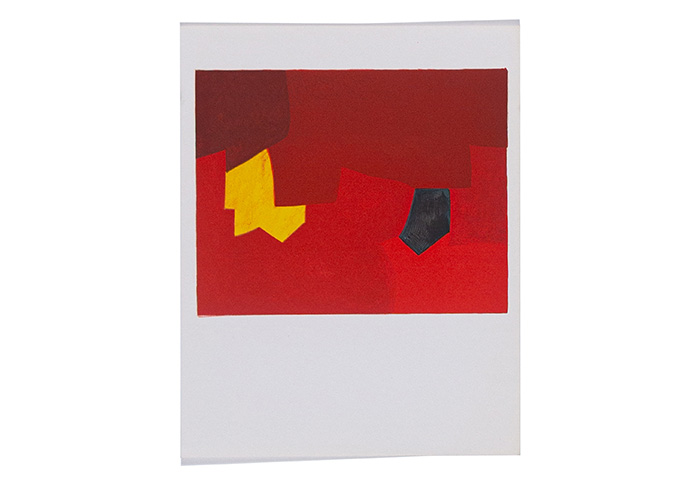






Serge Poliakoff is a painter the major figures of the École de Paris at the beginning of the year 1900 in Moscow. This artisit is the thirteenth of fourteen children. His father is a supplier of horses for the Russian army and owns a racehorse stable.
In 1914, he begins to take drawing lessons and spends his childhood between religious icons he sees in churches with his mother and the vibrant cultural life and literary salons of the Russian aristocracy.
In 1918, his exodus across Europe begins, accompanying his aunt, a famous singer, playing the guitar. He finally arrives in Paris in 1923 and begins his long training that will last for twenty years.
In 1937, he becomes close to the Delaunay painters whose theoretical discussions greatly assist his development. Two years later, he exhibits his first abstract painting and compositions in Paris. Noted by the painter Kandinsky, who says, “I bet on Poliakoff for the future.” He then participates in several salons and organizes his first exhibition of abstract paintings in 1945. The artist subsequently receives the Kandinsky Prize in 1947.
Meanwhile, to make ends meet, Serge Poliakoff creates successful fabric designs. However, he abandons this activity for fear that it might adversely affect his painting and compositions. Instead, he prefers to play the guitar in Russian cabarets at night.
He is then exhibited several times at the Denise René Gallery. From 1951 onwards, he exhibits at the Dina Vierny Gallery after their chance meeting in a Russian cabaret where Dina Vierny was replacing a sick singer.
The artist can finally enjoy success in the 1950s and 60s with numerous exhibitions and awards, as well as his participation in the 1962 Venice Biennale. He passes away in 1969, just before his major retrospective at the Museum of Modern Art in Paris.
Deeply influenced by Russian icons, he tries in his painting to convey the same emotion. This iconic aspect is reflected in his admiration for Malevich’s “White Square on White Background,” which had a significant impact on his work.
This painter seeks to express the presence of existence in his work, searching for a pre-figurative primitivism. Like the American artists of his generation (Rothko, Gottlieb, Newman). This is expressed in the balance of forms in his compositions, with the soul of the work relying on the vibration and colorful intensity emanating from it. Serge Poliakoff did not seek novelty in his painting but eternity, turning his paintings into true divine images, icons of modern art.
Serge Poliakoff : Silent Paintings, Timothee Taylor, Londres (14 janvier – 21 février)
Poliakoff, le rêve des formes, Musée d’Art Moderne de la Ville de Paris, Paris (18 octobre 2013 au 23 février 2014)
Serge Poliakoff – 60 ans déjà, Galerie Dina Vierny, Paris (11 mai – 28 juillet)
Serge Poliakoff, Musée des Beaux-Arts, Dunkerque (2 mars – 2 juin)
Serge Poliakoff, Association Campredon Art et Culture, L’Isle-sur-la-Sorgue, (7 avril – 10 juin)
Serge Poliakoff, Fondation Dina Vierny – Musée Maillol, Paris (20 novembre – 14 avril 1996)
Serge Poliakoff, Fondation Pierre Gianadda, Martigny, (31 janvier – 29 mars)
Serge Poliakoff, Association Campredon Art et Culture, L’Isle-sur-la-Sorgue (4 juillet – 12 octobre)
Serge Poliakoff, Galerie Dina Vierny, Paris (octobre)
Serge Poliakoff, Musée Ingres, Montauban (26 avril – 26 mai)
Serge Poliakoff, Musée des Beaux-Arts, La Chaux-de-Fonds
Rétrospective Poliakoff, Palais des Beaux-Arts, Charleroi (30 septembre – 2 novembre)
Serge Poliakoff, Musée Fabre, Montpellier (23 juillet – 15 octobre)
Serge Poliakoff, Musée des Beaux-Arts, Copenhague (3 mars – 9 avril)
Serge Poliakoff, Musée de Tel-Aviv, Tel-Aviv (27 décembre – 1er janvier 1972)
Serge Poliakoff, Musée National d’Art Moderne, Paris (22 septembre – 16 novembre)
Serge Poliakoff, Galerie Dina Vierny, Paris (29 septembre – octobre)
Serge Poliakoff, Galerie Dina Vierny, Paris (1er – 30 juin)
Serge Poliakoff, Museum am Ostwall, Dortmund (2 novembre – 1er décembre)
Salle Poliakoff, Pavillon Français, 31e Biennale, Venise (16 juin – 7 octobre)
Serge Poliakoff, Kunsthalle, Berne (9 avril – 15 mai)
Loan Exhibition of Paintings by Serge Poliakoff, The Phillips Collection, Washington D.C ( 15 février – 10 mars)
Jacobsen – Poliakoff, Stateus Museum for Kunst, Copenhague (30 mai – 15 juin)
Serge Poliakoff, Knoedler Galleries, New York, (10 – 29 octobre)
Serge Poliakoff, Galerie Martinet, Amsterdam (4 – 23 mars)
Serge Poliakoff, Galerie Bing, Paris (28 octobre – 28 novembre)
Serge Poliakoff, Circle & Square Gallery, New York (3 – 21 mars)
Poliakoff – Gilioli, Palais des Beaux-Arts, Bruxelles (25 avril – 6 mai)
Serge Poliakoff, Galerie Dina Vierny, Paris (21 novembre – 12 décembre)
Serge Poliakoff, Galerie Denise René, Paris (11 février – 2 mars)
Serge Poliakoff, Galerie Tokanten, Copenhague (16 – 28 octobre)
Serge Poliakoff, Galerie Zak, Paris (septembre)
Accrochage d’été, Galerie Dina Vierny, Paris (1er – 30 juillet)
Au cœur de l’abstraction – Collection de la Fondation Gandur pour l’Art, Fondation Marguerite et Aimé Maeght, Saint-Paul de Vence (2 juillet – 20 novembre)
Gilioli – Poliakoff, Galerie Dina Vierny, Paris (8 avril – 4 juillet)
Exposition anniversaire 70 ans, Galerie Dina Vierny, Paris (25 janvier – 24 mars)
Paris : Capital de las Artes 1900-1968, Museo Guggenheim, Bilbao (27 mai – 3 septembre)
L’Art Russe en Exil à Paris, 1920-1970, Musée d’Art Moderne et d’Art Contemporain, Nice (30 juin – 30 septembre)
Manifeste – une Histoire parallèle 1960-1990, Centre Georges Pompidou, Paris (23 septembre – 13 décembre)
Polyptiques, Musée du Louvre, Paris (27 mars – 23 juillet)
Salon International des Musées et Expositions, Grand Palais, Paris (15 – 20 janvier)
Art Français du XXe Siècle, Salle Poliakoff, National Museum of Modern and Contemporary Art, Séoul (26 août – 31 octobre)
Salon d’Automne, Hommage à Serge Poliakoff, Grand Palais, Paris (5 – 29 novembre)
L’abstraction lyrique en Europe, Musée d’Art Contemporain, Montréal
Paris – New York, Musée national d’Art moderne – Centre Georges Pompidou, Paris (1er juin – 19 septembre)
Collections, Musée d’Art moderne de la Ville de Paris, Paris
Art du XXe Siècle – collections genevoises, Musée Rath, Genève (28 juin – 23 septembre)
L’École de Paris dans les collections luxembourgeoises, Musée d’Art et d’Histoire, Luxembourg (mai)
8th International Art Exhibition of Japan (prix international de la Biennale de Tokyo), Tokyo
33e Biennale, Venise
Arp, Dubuffet, Fautrier, Giacometti, Herbin, Mathieu, Mortensen, Osborne, Poliakoff, Vasarely, Vieira da Silva, Kunsthaus, Zürich
Acquisitions 1953-1961, The Solomon R. Guggenheim Museum, New York (19 avril – 21 juin)
L’École de Paris dans les Collections Belges, Musée National d’Art Moderne, Paris (9 juillet)
Exposition Universelle 50 ans d’Art Moderne, Palais International des Beaux-Arts, Bruxelles (17 avril – 19 octobre)
Serge Poliakoff, Fahr El Nissa Zeid, James Pichette, Galerie Dina Vierny, Paris (29 octobre – 15 novembre)
Bloc, Dewasne, Deyrolle, Herbin, Mortensen, Poliakoff, Vasarely, A.P.I.A.W., Liège (16 – 28 octobre)
Collection Philippe Dotremont, Stedelijk Museum, Amsterdam
Tendance, Galerie Maeght, Paris (19 octobre)
Do Figurativismo ao Abstractionismo, Museu de Arte Moderna, São Paulo
5ème Exposition : Del Marle, Dewasne, Deyrolle, Domela, Fleischmann, Hartung, Herbin, Kandinsky, Demonda, Engel Pak, Serge Poliakoff, Marie Raymond, Schneider, N. Warb, Salle du Centre des Recherches – rue Cujas, Paris (29 mai – 22 juin)
Salon des Artistes Français, Grand Palais, Paris
Galerie Drouant, Paris
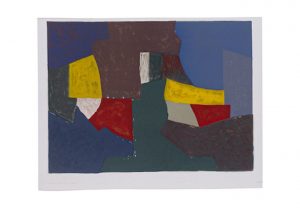
44 x 33.5 cm

Serge Poliakoff is a painter the major figures of the École de Paris at the beginning of the year 1900 in Moscow. This artisit is the thirteenth of fourteen children. His father is a supplier of horses for the Russian army and owns a racehorse stable. In 1914, he begins to take drawing lessons and spends his childhood between religious icons he sees in churches with his mother and the vibrant cultural life and literary salons of the Russian aristocracy. In 1918, his exodus across Europe begins, accompanying his aunt,…
Serge Poliakoff is a painter the major figures of the École de Paris at the beginning of the year 1900 in Moscow. This artisit is the thirteenth of fourteen children. His father is a supplier of horses for the Russian army and owns a racehorse stable.
In 1914, he begins to take drawing lessons and spends his childhood between religious icons he sees in churches with his mother and the vibrant cultural life and literary salons of the Russian aristocracy.
In 1918, his exodus across Europe begins, accompanying his aunt, a famous singer, playing the guitar. He finally arrives in Paris in 1923 and begins his long training that will last for twenty years.
In 1937, he becomes close to the Delaunay painters whose theoretical discussions greatly assist his development. Two years later, he exhibits his first abstract painting and compositions in Paris. Noted by the painter Kandinsky, who says, “I bet on Poliakoff for the future.” He then participates in several salons and organizes his first exhibition of abstract paintings in 1945. The artist subsequently receives the Kandinsky Prize in 1947.
Meanwhile, to make ends meet, Serge Poliakoff creates successful fabric designs. However, he abandons this activity for fear that it might adversely affect his painting and compositions. Instead, he prefers to play the guitar in Russian cabarets at night.
He is then exhibited several times at the Denise René Gallery. From 1951 onwards, he exhibits at the Dina Vierny Gallery after their chance meeting in a Russian cabaret where Dina Vierny was replacing a sick singer.
The artist can finally enjoy success in the 1950s and 60s with numerous exhibitions and awards, as well as his participation in the 1962 Venice Biennale. He passes away in 1969, just before his major retrospective at the Museum of Modern Art in Paris.
Deeply influenced by Russian icons, he tries in his painting to convey the same emotion. This iconic aspect is reflected in his admiration for Malevich’s “White Square on White Background,” which had a significant impact on his work.
This painter seeks to express the presence of existence in his work, searching for a pre-figurative primitivism. Like the American artists of his generation (Rothko, Gottlieb, Newman). This is expressed in the balance of forms in his compositions, with the soul of the work relying on the vibration and colorful intensity emanating from it. Serge Poliakoff did not seek novelty in his painting but eternity, turning his paintings into true divine images, icons of modern art.
Serge Poliakoff : Silent Paintings, Timothee Taylor, Londres (14 janvier – 21 février)
Poliakoff, le rêve des formes, Musée d’Art Moderne de la Ville de Paris, Paris (18 octobre 2013 au 23 février 2014)
Serge Poliakoff – 60 ans déjà, Galerie Dina Vierny, Paris (11 mai – 28 juillet)
Serge Poliakoff, Musée des Beaux-Arts, Dunkerque (2 mars – 2 juin)
Serge Poliakoff, Association Campredon Art et Culture, L’Isle-sur-la-Sorgue, (7 avril – 10 juin)
Serge Poliakoff, Fondation Dina Vierny – Musée Maillol, Paris (20 novembre – 14 avril 1996)
Serge Poliakoff, Fondation Pierre Gianadda, Martigny, (31 janvier – 29 mars)
Serge Poliakoff, Association Campredon Art et Culture, L’Isle-sur-la-Sorgue (4 juillet – 12 octobre)
Serge Poliakoff, Galerie Dina Vierny, Paris (octobre)
Serge Poliakoff, Musée Ingres, Montauban (26 avril – 26 mai)
Serge Poliakoff, Musée des Beaux-Arts, La Chaux-de-Fonds
Rétrospective Poliakoff, Palais des Beaux-Arts, Charleroi (30 septembre – 2 novembre)
Serge Poliakoff, Musée Fabre, Montpellier (23 juillet – 15 octobre)
Serge Poliakoff, Musée des Beaux-Arts, Copenhague (3 mars – 9 avril)
Serge Poliakoff, Musée de Tel-Aviv, Tel-Aviv (27 décembre – 1er janvier 1972)
Serge Poliakoff, Musée National d’Art Moderne, Paris (22 septembre – 16 novembre)
Serge Poliakoff, Galerie Dina Vierny, Paris (29 septembre – octobre)
Serge Poliakoff, Galerie Dina Vierny, Paris (1er – 30 juin)
Serge Poliakoff, Museum am Ostwall, Dortmund (2 novembre – 1er décembre)
Salle Poliakoff, Pavillon Français, 31e Biennale, Venise (16 juin – 7 octobre)
Serge Poliakoff, Kunsthalle, Berne (9 avril – 15 mai)
Loan Exhibition of Paintings by Serge Poliakoff, The Phillips Collection, Washington D.C ( 15 février – 10 mars)
Jacobsen – Poliakoff, Stateus Museum for Kunst, Copenhague (30 mai – 15 juin)
Serge Poliakoff, Knoedler Galleries, New York, (10 – 29 octobre)
Serge Poliakoff, Galerie Martinet, Amsterdam (4 – 23 mars)
Serge Poliakoff, Galerie Bing, Paris (28 octobre – 28 novembre)
Serge Poliakoff, Circle & Square Gallery, New York (3 – 21 mars)
Poliakoff – Gilioli, Palais des Beaux-Arts, Bruxelles (25 avril – 6 mai)
Serge Poliakoff, Galerie Dina Vierny, Paris (21 novembre – 12 décembre)
Serge Poliakoff, Galerie Denise René, Paris (11 février – 2 mars)
Serge Poliakoff, Galerie Tokanten, Copenhague (16 – 28 octobre)
Serge Poliakoff, Galerie Zak, Paris (septembre)
Accrochage d’été, Galerie Dina Vierny, Paris (1er – 30 juillet)
Au cœur de l’abstraction – Collection de la Fondation Gandur pour l’Art, Fondation Marguerite et Aimé Maeght, Saint-Paul de Vence (2 juillet – 20 novembre)
Gilioli – Poliakoff, Galerie Dina Vierny, Paris (8 avril – 4 juillet)
Exposition anniversaire 70 ans, Galerie Dina Vierny, Paris (25 janvier – 24 mars)
Paris : Capital de las Artes 1900-1968, Museo Guggenheim, Bilbao (27 mai – 3 septembre)
L’Art Russe en Exil à Paris, 1920-1970, Musée d’Art Moderne et d’Art Contemporain, Nice (30 juin – 30 septembre)
Manifeste – une Histoire parallèle 1960-1990, Centre Georges Pompidou, Paris (23 septembre – 13 décembre)
Polyptiques, Musée du Louvre, Paris (27 mars – 23 juillet)
Salon International des Musées et Expositions, Grand Palais, Paris (15 – 20 janvier)
Art Français du XXe Siècle, Salle Poliakoff, National Museum of Modern and Contemporary Art, Séoul (26 août – 31 octobre)
Salon d’Automne, Hommage à Serge Poliakoff, Grand Palais, Paris (5 – 29 novembre)
L’abstraction lyrique en Europe, Musée d’Art Contemporain, Montréal
Paris – New York, Musée national d’Art moderne – Centre Georges Pompidou, Paris (1er juin – 19 septembre)
Collections, Musée d’Art moderne de la Ville de Paris, Paris
Art du XXe Siècle – collections genevoises, Musée Rath, Genève (28 juin – 23 septembre)
L’École de Paris dans les collections luxembourgeoises, Musée d’Art et d’Histoire, Luxembourg (mai)
8th International Art Exhibition of Japan (prix international de la Biennale de Tokyo), Tokyo
33e Biennale, Venise
Arp, Dubuffet, Fautrier, Giacometti, Herbin, Mathieu, Mortensen, Osborne, Poliakoff, Vasarely, Vieira da Silva, Kunsthaus, Zürich
Acquisitions 1953-1961, The Solomon R. Guggenheim Museum, New York (19 avril – 21 juin)
L’École de Paris dans les Collections Belges, Musée National d’Art Moderne, Paris (9 juillet)
Exposition Universelle 50 ans d’Art Moderne, Palais International des Beaux-Arts, Bruxelles (17 avril – 19 octobre)
Serge Poliakoff, Fahr El Nissa Zeid, James Pichette, Galerie Dina Vierny, Paris (29 octobre – 15 novembre)
Bloc, Dewasne, Deyrolle, Herbin, Mortensen, Poliakoff, Vasarely, A.P.I.A.W., Liège (16 – 28 octobre)
Collection Philippe Dotremont, Stedelijk Museum, Amsterdam
Tendance, Galerie Maeght, Paris (19 octobre)
Do Figurativismo ao Abstractionismo, Museu de Arte Moderna, São Paulo
5ème Exposition : Del Marle, Dewasne, Deyrolle, Domela, Fleischmann, Hartung, Herbin, Kandinsky, Demonda, Engel Pak, Serge Poliakoff, Marie Raymond, Schneider, N. Warb, Salle du Centre des Recherches – rue Cujas, Paris (29 mai – 22 juin)
Salon des Artistes Français, Grand Palais, Paris
Galerie Drouant, Paris



